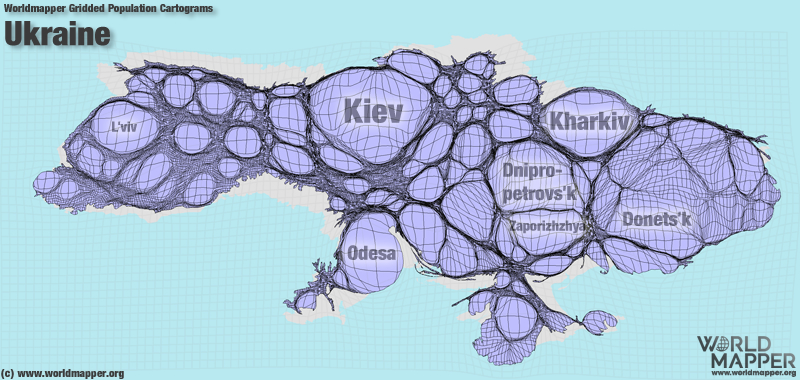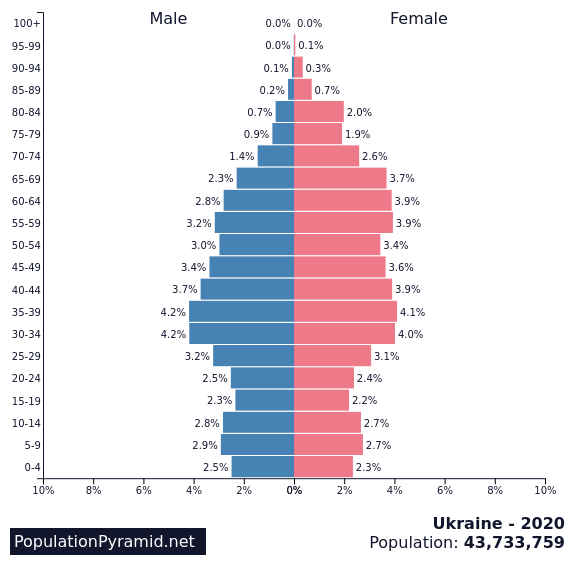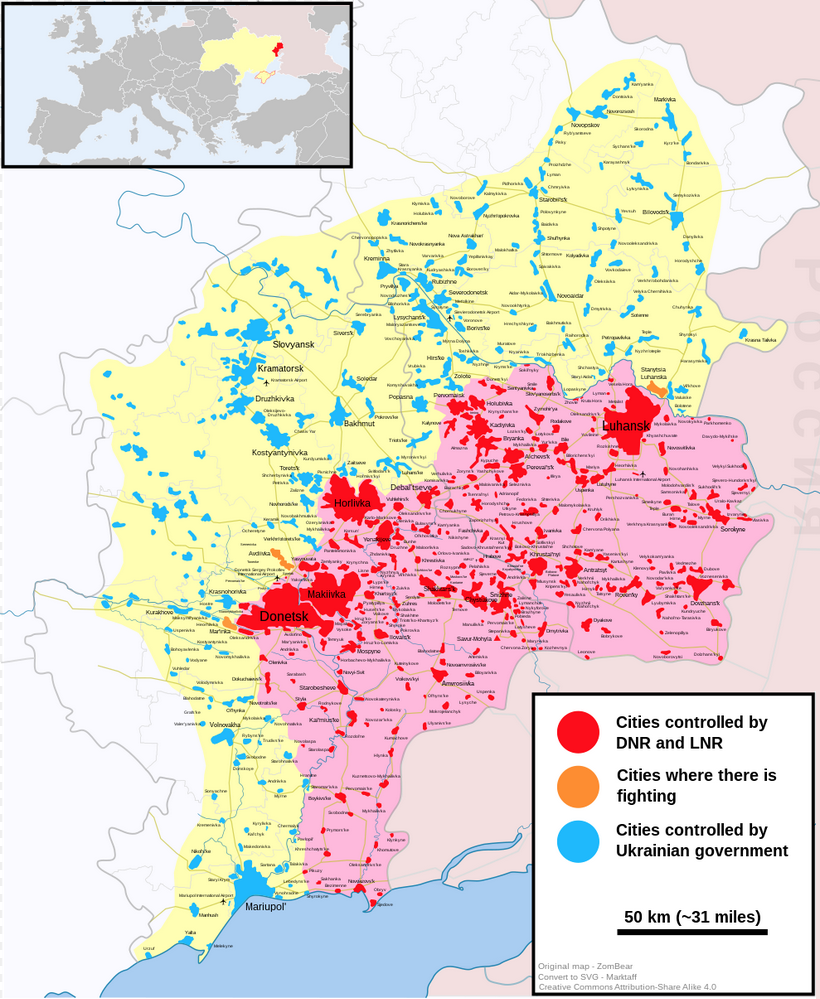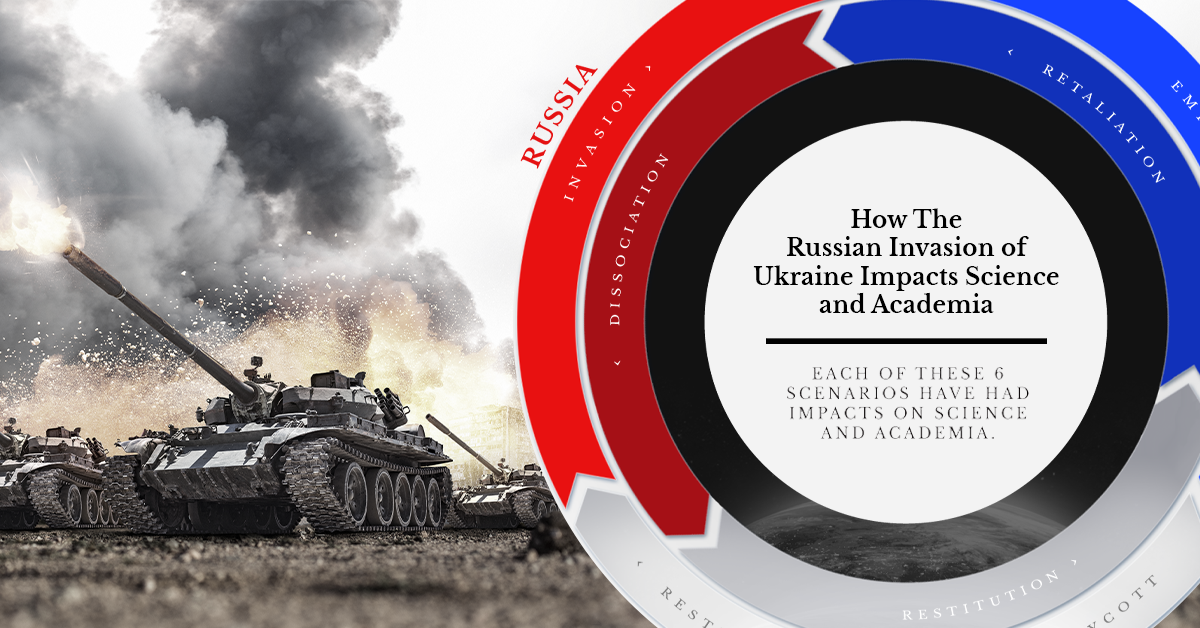In the map graphic above, we examine Ukraine from a structural point of view. What’s the country’s population composition? What drives the country’s economy? And most importantly, why is the country important within a global context?
Where Do People Live in Ukraine?
With a population of nearly 44 million people, Ukraine is the eighth-most populous country in Europe. For perspective, that is slightly smaller than Spain, and four times larger than Greece. As the cartogram below demonstrates, a large portion of the country’s population is located in and around the capital Kyiv, along with the Donetsk region—which is front and center in the current conflict with Russia.
Not surprisingly, many of the country’s Russian speaking citizens live on the eastern side of the country, near the Russian border.
Key Facts About Ukraine’s Demographics
Ukrainians make up almost 78% of the total population, while Russians represent around 17% of the population, making it the single-largest Russian diaspora in the world. Other minorities include:
Belarusians: 0.6% Bulgarians: 0.4% Hungarians: 0.3% Crimean Tatars: 0.5% Romanians: 0.3% Poles: 0.3% Jews: 0.2%
The country’s population has been declining since the 1990s because of a high emigration rate, and high death rates coupled with a low birth rate. The majority of the population is Christian (80%), with 60% declaring adherence to one or another strand of the Orthodox Church.
Ukraine’s Economy: An Overview
When the Soviet Union collapsed, Ukraine turned over thousands of atomic weapons in exchange for security guarantees from Russia, the United States, and other countries. However, the defense industry continues to be a strategically important sector and a large employer in Ukraine. The country exports weapons to countries like India, Saudi Arabia, and Turkey. Furthermore, Ukraine is rich in natural resources, particularly in mineral deposits. It possesses the world’s largest reserves of commercial-grade iron ore—30 billion tonnes of ore or around one-fifth of the global total. It’s also worth noting that Ukraine ranks second in terms of known natural gas reserves in Europe, which today remain largely untapped. Ukraine’s mostly flat geography and high-quality soil composition make the country a big regional agricultural player. The country is the world’s fifth-largest exporter of wheat and the world’s largest exporter of seed oils like sunflower and rapeseed. Coal mining, chemicals, mechanical products (aircraft, turbines, locomotives and tractors) and shipbuilding are also important sectors of the Ukrainian economy.
The Bear in the Room
Given the country’s location and history, it’s nearly impossible to talk about Ukraine without mentioning nearby Russia. The country shares borders with Russia both to the east and northeast. For context, a car trip from Moscow to one of the Ukrainian border cities, Shostka, takes around 8 hours. To the Northwest, Ukraine also shares borders with Belarus—a country that is closely aligned with the Kremlin. To the southeast is Crimea, a peninsula entirely surrounded by both the Black Sea and the smaller Sea of Azov. In 2014, Russia annexed the peninsula and established two federal subjects, the Republic of Crimea and the federal city of Sevastopol. The annexation was widely condemned around the world, and the territories are recognized by most of the international community as being part of Ukraine. The region was of particular interest to Russia since Moscow depends on the Black Sea for access to the Mediterranean. The Port of Sevastopol, on the southwest edge of Crimea, is one of the few ice-free deepwater ports available to Russia in the region. Due to ongoing tensions between the two countries, Ukraine has been seeking to reduce Russia’s leverage over its economy. As a result, China and Poland have surpassed Russia as Ukraine’s largest country trading partners in recent years. However, Ukraine still remains an important route for Russian gas that heats millions of homes, generates electricity, and powers factories in Europe. The continent gets nearly 40% of its natural gas and 25% of its oil from Russia. Furthermore, Ukraine is connected to the same power grid as Russia, so it remains dependent on Moscow in the event of a shortfall. Even as conflict heats up, the two countries still share economic links, which will influence how the situation unfolds.
Conflict in the Donbas Region
Ukraine stands at the center of a geopolitical rivalry between western powers and Russia, and that rivalry is flaring up once again. Two regions along the Russian border—Donetsk and Luhansk—have been a conflict zone since 2014, when pro-Russian separatists began clashing with government forces. The map below shows the relative contact zone between the two opposing forces. Currently Russia has troops and military equipment amassed at various points along the border between the two countries, as well as in neighboring Belarus. In recent days, Russian President Vladimir Putin ordered troops into two breakaway regions in eastern Ukraine, recognizing them as independent states. This recognition serves as a definitive end point to the seven-year peace deal known as the Minsk agreement. As this conflict heats up, it remains to be seen what will happen to the roughly 5 million people who live in the Donbas region. Note: As of February 23rd, 2022, Russia launched a full-scale military operation into Ukraine. The situation is still evolving rapidly. on After a year of casualties, structural devastation, and innumerable headlines, the conflict drags on. Many report the impacts to the economy, social demographics, and international relationships, but how do science and academia fair in the throes of war? Within the actions and responses of the conflict, we take a look at how six key scenarios globally shape science.
War’s Material Impacts to Science
1. Russia Invades Ukraine
The assault to research infrastructure in Ukraine is devastating. Approximately 27% of buildings are damaged or destroyed. The country’s leading scientific research centers, like the Kharkiv Institute of Physics and Technology, or the world’s largest decameter-wavelength radio telescope, are in ruins. While the majority of research centers remain standing, many are not operating. Amidst rolling blackouts and disruptions, a dramatic decrease in research funds (as large as 50%) has cut back scientific activity in the country. Rebuilding efforts are underway, but the extent to which it will return to its former capacity remains to be seen.
2. Ukraine Fights Back
As research funds have been redirected to the military, and scientists, too, have pivoted in a similar way. Martial law and general mobilization have enlisted male researchers, especially those with military experience and those within the 18-60 age range. Women were exempt until July 2022. Those with degrees in chemistry, biology, and telecommunications were required to enter the military registry. For both men and women researchers alike, these requirements meant staying in the country for the remainder of the year. Extensions for mobilization have subsided as of February 19th, 2023.
Social Impacts of War to Science
3. Western Leaders Exclude Russia
One year ago, scientists and institutions around the world immediately launched into protest against Russia’s escalation:
The European Commission agreed to cease payments to Russian participants and to not renew contract agreements for Horizon Europe The $300-million, MIT-led Skoltech program was dissolved one day after the war began, with no foreseeable restart in the future Various governments and research councils in the European Union froze collaborations and discouraged working with Russian institutions The European Organization for Nuclear Research, CERN, barred all Russian observers and will dismiss almost 8% of its workers—about 1,000 Russian scientists—hen contracts expire later this year
These condemnations, and more, remain in effect today and are emboldened by what has come to be known as a “scientific boycott”. Journal publishers around the world imposed some of their own sanctions on Russian institutions and scientists in light of this boycott. These range from prohibiting Russian manuscript submissions (Elsevier’s Journal of Molecular Structure) to scrubbing journal indices of Russian papers and authors.
4. Russia Dissociates from the West
As a response to the sanctions imposed on the Russian economy, Russia ceases to sell natural gas to most of Europe. Institutions are reassessing their usage and dependence on Russian energy, but alternatives are not yet affordable. The German Electron Synchrotron (DESY) in Hamburg, home to the world’s most powerful X-ray laser, is struggling with rising electricity costs. CERN, for instance, has already cut its data collection for the year by two weeks in order to save money. This makes it difficult for pre-war projects to continue collaborating with Russia. As a result, there are questions about how withdrawals may be affecting Russian science, too. For now, that remains relatively unknown, though some have guesses. Young scientists, many barred from attending international conferences and meetings, may seek employment or opportunity elsewhere to develop their careers. Some speculate a “brain drain” effect may occur, similar to the academic fallout of the Soviet Union’s collapse in the 1990s. How Russia will participate in pre-war international research collaborations is still unknown. For now, a number of pre-war projects ranging from the Arctic to the fire-prone wilds of northern Russia are on hold. All of these scenarios paint a concerning picture about the progress of research. There are indications that Russian scientific collaboration may already be shifting eastward.
Philanthropic Impacts of War to Science
5. New Homes for Ukrainian Science
Finding support for Ukrainians emigrating from the conflict is difficult, but not impossible. Though many Ukrainians scientists remain in the country making the best of a difficult situation, approximately 6,000 are now living abroad. Most Ukrainian emigrants are now living in Poland and Germany. Some scientists continue to work remotely, supporting projects at their home institutions or with new research programs they’ve found since relocating. These success stories are thanks to the work of a number of ad-hoc mobilizations that help keep researchers working in the European cooperation. Groups like MSC4Ukraine help postdoc students and researchers find new opportunities across Europe. Social media trends like #Science4Ukraine help connect researchers to other supportive movements.
6. The International Rebuilding of Ukrainian Science
Various research institutions have also lent support to the survival and rebuilding of science in Ukraine:
The largest science prize, the Breakthrough Prize, recently donated $3 million to fund research programs and reconstruction efforts Federal research councils, like those in Netherlands and Switzerland, also have programs to formally support displaced scientists and researchers The European Union is investigating new funding schemes that could repurpose almost €320 billion of frozen Russian Federal Reserves
No Consensus on Boycott
While the Western front seems united in it’s condemnation of the war, the international science community isn’t in total agreement with a science boycott. Some scientists argue that excluding Russian scientists—especially those who have vocalized their disdain for the war—serves to punish unrelated individuals. This fractures the benefits of international scientific exchange. Others, especially those in countries who are economically dependent on Russia, have remained silent or even supported the invasion. In these cases, Russia’s science initiatives may lean more heavily in their direction. It’s easy to appreciate how war complicates many different angles of the global research ecosystem. After one year, how things will turn out remains a mystery. But one thing is for certain: science adapts and progresses even in the bleakest times. For now, supporting all efforts to reduce conflict remains in science’s best interests. Full sources here















